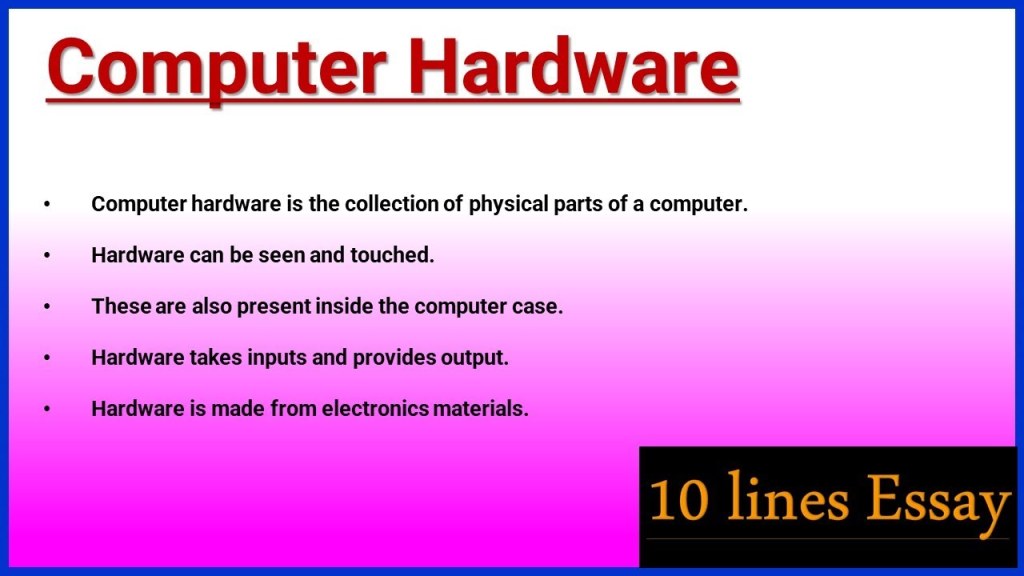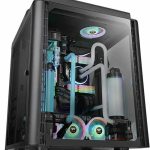The Power Of Computer Hardware In A Sentence: Unleash Your Potential Now!
Computer Hardware in a Sentence
Introduction
Hello Readers,
1 Picture Gallery: The Power Of Computer Hardware In A Sentence: Unleash Your Potential Now!

Welcome to our article on computer hardware in a sentence. In today’s digitally-driven world, computer hardware plays a crucial role in our daily lives. From personal computers to smartphones, we rely on hardware components to perform various tasks. In this article, we will explore the different aspects of computer hardware and its significance in our lives.

Image Source: ytimg.com
So, let’s dive in and discover the world of computer hardware!
What is Computer Hardware?
Computer hardware refers to the physical components of a computer system that can be seen, touched, and manipulated. It encompasses everything from the central processing unit (CPU) to input and output devices, memory, and storage devices. These components work together to enable the functioning of a computer.
The Central Processing Unit (CPU)
The CPU is often referred to as the brain of a computer. It is responsible for executing instructions and performing calculations. Without a CPU, a computer would not be able to process data and carry out tasks.
Input and Output Devices
Input devices allow users to input data into a computer system, while output devices display or produce the results of those inputs. Examples of input devices include keyboards, mice, and scanners, while monitors and printers are common output devices.
Memory and Storage Devices
Memory and storage devices hold the data and instructions that are currently being used or stored for future use. Random access memory (RAM) provides temporary storage for data and instructions during processing, while storage devices such as hard drives and solid-state drives (SSDs) store data for long-term use.
Who Uses Computer Hardware?
Computer hardware is used by a wide range of individuals and organizations. From students and professionals to businesses and government agencies, almost everyone relies on computer hardware in some form or another. Whether it’s for personal use, academic purposes, or professional work, computer hardware is an essential tool in today’s digital age.
Students and Academics
Students and academics rely on computer hardware for various tasks, including research, writing assignments, and online learning. Laptops, desktop computers, and other hardware components enable them to access information, create content, and collaborate with others.
Professionals
Professionals from different industries heavily depend on computer hardware to carry out their job responsibilities. From graphic designers using powerful computers for rendering high-quality images to engineers utilizing specialized hardware for simulations, computer hardware enhances productivity and enables efficient workflow.
Businesses and Organizations
Businesses and organizations utilize computer hardware for various purposes, such as managing finances, communication, and data storage. Servers, networking equipment, and computers are essential components in enabling smooth operations and facilitating efficient information flow within an organization.
When and Where is Computer Hardware Used?
Computer hardware is used in various settings and scenarios, both in personal and professional environments. Its usage can be observed in homes, offices, educational institutions, research centers, hospitals, and many other places where digital technologies are employed.
Home and Personal Use
At home, computer hardware is used for entertainment, communication, and personal productivity. It enables individuals to access the internet, watch videos, play games, create content, and store personal files.
Offices and Workplaces
In offices and workplaces, computer hardware is essential for day-to-day operations. It enables employees to perform tasks such as creating documents, managing databases, sending emails, and conducting virtual meetings. Additionally, hardware components such as servers and networking equipment support the smooth functioning of an organization’s IT infrastructure.
Educational Institutions
Educational institutions heavily rely on computer hardware to facilitate teaching and learning activities. Hardware components such as desktop computers, laptops, and interactive whiteboards enable students and teachers to access educational resources, collaborate on projects, and enhance the learning experience.
Why is Computer Hardware Important?
Computer hardware holds immense importance in today’s digital age. Here are some reasons why computer hardware is vital:
Enables Digital Transformation
Computer hardware enables individuals, organizations, and societies to undergo digital transformation. It empowers them to leverage technology for enhanced productivity, communication, and problem-solving.
Facilitates Information Processing
Computer hardware facilitates the processing of vast amounts of information. From analyzing data and running complex algorithms to executing tasks efficiently, computer hardware enables rapid information processing, leading to informed decision-making.
Enhances Communication and Connectivity
Computer hardware, such as networking equipment and communication devices, enables seamless communication and connectivity. It allows individuals to connect with others globally, share information, and collaborate on projects regardless of geographical boundaries.
How Does Computer Hardware Work?
Computer hardware works by utilizing a combination of electrical, mechanical, and optical components to perform various tasks. Here’s a brief overview of how computer hardware functions:
Process Execution
When a user initiates a task on a computer, such as opening an application, the CPU receives the corresponding instructions. The CPU then interprets and executes these instructions, performing the necessary calculations and operations.
Data Storage and Retrieval
Data storage and retrieval involve the use of memory and storage devices. When data is generated or inputted, it is temporarily stored in RAM for quick access. Long-term storage is facilitated by hard drives or SSDs, where data can be stored persistently even when the computer is turned off.
Input and Output Operations
Input and output devices enable users to interact with a computer system. Input devices convert user actions, such as typing on a keyboard or moving a mouse, into digital signals that can be processed by the computer. Output devices display or produce the results of these processed signals, such as displaying images on a monitor or printing documents.
Communication and Connectivity
Networking hardware and communication devices enable computers to connect with each other and transfer data. This enables individuals to access remote resources, share files, and communicate with others via networks and the internet.
Advantages and Disadvantages of Computer Hardware
Like any technology, computer hardware comes with its own set of advantages and disadvantages. Let’s explore them:
Advantages of Computer Hardware
1. Increased Efficiency: Computer hardware enhances efficiency by automating tasks, processing information quickly, and enabling multitasking.
2. Improved Communication: Hardware components such as networking devices enable seamless communication, collaboration, and information sharing.
3. Enhanced Productivity: With the help of powerful hardware components, individuals can accomplish tasks more efficiently and effectively.
4. Access to Information: Computer hardware provides access to a vast amount of information available on the internet and other digital resources.
5. Innovation and Advancements: Computer hardware drives technological advancements and innovation in various fields, leading to improved products and services.
Disadvantages of Computer Hardware
1. Cost: High-end computer hardware can be expensive, making it inaccessible for individuals or organizations with budget constraints.
2. Environmental Impact: The manufacturing and disposal of computer hardware components contribute to environmental issues, such as electronic waste and energy consumption.
3. Security Risks: Computer hardware can be vulnerable to security threats, such as viruses, malware, and unauthorized access, leading to data breaches and privacy concerns.
4. Dependency: Over-reliance on computer hardware can lead to dependency issues, where individuals or organizations may struggle to function without functioning hardware components.
5. Obsolescence: Computer hardware becomes outdated over time as technology advances, requiring frequent upgrades or replacements to remain up-to-date.
Frequently Asked Questions (FAQs)
1. Can computer hardware be upgraded?
Yes, computer hardware can be upgraded. Components such as RAM, storage devices, and graphics cards can be replaced or added to improve performance or accommodate changing needs.
2. What should I consider when buying computer hardware?
When buying computer hardware, consider factors such as your specific requirements, budget, compatibility with existing components, and future upgradability.
3. How long does computer hardware typically last?
The lifespan of computer hardware varies depending on factors such as quality, usage, and technological advancements. On average, most hardware components last between 3 to 5 years.
4. What are the common signs of hardware failure?
Common signs of hardware failure include frequent crashes or freezes, slow performance, unusual noises, overheating, and error messages related to specific hardware components.
5. How can I maintain computer hardware for optimal performance?
To maintain computer hardware, regularly clean dust from components, update drivers and firmware, install security updates, backup important data, and use reliable antivirus software.
Conclusion
Computer hardware is the backbone of our digital world. From the powerful processors that enable complex calculations to the input and output devices that facilitate communication, computer hardware plays a vital role in our daily lives. Understanding the different components and their functions can help us make informed decisions when it comes to purchasing and using computer hardware.
So, embrace the world of computer hardware and explore the endless possibilities it offers!
Final Remarks
In conclusion, computer hardware is an integral part of our modern society. It empowers individuals, organizations, and societies to achieve greater heights in terms of productivity, connectivity, and innovation. However, it is essential to use computer hardware responsibly, considering its environmental impact and security concerns. By staying informed and making conscious choices, we can harness the power of computer hardware for the betterment of our lives and the world around us.
This post topic: Computer Hardware


